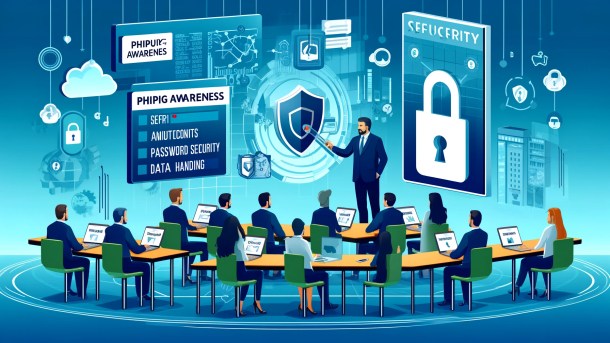While technological solutions are vital, the human factor plays a critical role in safeguarding sensitive information. Training employees in cybersecurity is essential to fortifying an organization’s defenses and mitigating risks. Let’s explore why cybersecurity training is crucial and how to implement effective programs.
The Importance of Cybersecurity Training
The Human Element in Cybersecurity
Despite advancements in technology, human error remains one of the leading causes of cybersecurity breaches. Employees can inadvertently expose the organization to risks through actions such as clicking on phishing emails, using weak passwords, or mishandling sensitive data. Cybercriminals often exploit these vulnerabilities, making it imperative to address the human element in cybersecurity.
By training employees in cybersecurity best practices, organizations can significantly reduce the risk of breaches caused by human error. Educated and vigilant employees act as the first line of defense, identifying and responding to potential threats before they escalate.
Building a Security-Conscious Culture
Creating a culture of cybersecurity awareness within an organization is critical. When employees understand the importance of cybersecurity and their role in maintaining it, they are more likely to adopt secure behaviors and practices. This collective vigilance strengthens the overall security posture of the organization.
A security-conscious culture also fosters accountability, where employees recognize their responsibility in protecting sensitive information. Regular training and open communication about cybersecurity threats and best practices help reinforce this culture and keep it top of mind for everyone in the organization.
Implementing Effective Cybersecurity Training Programs
Assessing Training Needs
Before implementing a cybersecurity training program, it’s essential to assess the specific needs of the organization. Conducting a thorough risk assessment can help identify the most significant threats and vulnerabilities. This information can then be used to tailor the training program to address these specific areas of concern.
Additionally, understanding the varying levels of cybersecurity knowledge among employees is crucial. A one-size-fits-all approach may not be effective, as different roles within the organization may require different levels of training. Customized training modules can ensure that all employees receive the appropriate level of education and support.
Key Components of Cybersecurity Training
- Phishing Awareness: Training employees to recognize phishing emails and other social engineering attacks is vital. Interactive simulations and real-life examples can help employees identify red flags and respond appropriately.
- Password Security: Educating employees on the importance of strong, unique passwords and the use of password managers can prevent unauthorized access to systems and data.
- Data Handling: Training on proper data handling and storage practices ensures that sensitive information is protected from unauthorized access and breaches.
- Incident Reporting: Employees should know how to report suspicious activities and potential security incidents promptly. Clear reporting procedures and regular drills can facilitate swift and effective responses to threats.
Continuous Learning and Adaptation
Cybersecurity is a constantly evolving field, with new threats and vulnerabilities emerging regularly. As such, cybersecurity training should not be a one-time event but an ongoing process. Regular updates and refresher courses can help keep employees informed about the latest threats and best practices.
In addition to formal training sessions, organizations can leverage various resources such as newsletters, webinars, and online courses to provide continuous learning opportunities. Encouraging employees to stay current with cybersecurity trends and developments can further enhance their ability to protect the organization.
Leveraging Technology to Enhance Training
Gamification and Interactive Learning
Incorporating gamification and interactive elements into cybersecurity training can make the learning process more engaging and effective. Simulated cyber attack scenarios, quizzes, and challenges can help reinforce key concepts and test employees’ knowledge in a practical setting.
For example, a simulated phishing attack can help employees practice identifying and responding to suspicious emails in a controlled environment. This hands-on approach not only reinforces learning but also builds confidence in employees’ ability to handle real-world threats.
Utilizing Cybersecurity Tools
Various cybersecurity tools and platforms can be integrated into training programs to provide practical experience. For instance, employees can be trained on using secure communication tools, encryption software, and incident response platforms. Familiarity with these tools ensures that employees can effectively utilize them in their daily tasks, further enhancing the organization’s security posture.
Additionally, training platforms that offer real-time feedback and analytics can help track employee progress and identify areas that require further attention. This data-driven approach allows organizations to continuously improve their training programs and address any gaps in knowledge or skills.
Measuring the Effectiveness of Training Programs
Key Performance Indicators (KPIs)
To ensure the effectiveness of cybersecurity training programs, organizations should establish key performance indicators (KPIs) to measure progress and outcomes. Common KPIs include the number of reported phishing attempts, compliance with password policies, and the rate of successful incident reporting.
Regular assessments and evaluations can help determine whether the training program is achieving its objectives and identify areas for improvement. Surveys and feedback from employees can also provide valuable insights into the program’s effectiveness and areas where additional support may be needed.
Continuous Improvement
Cybersecurity training programs should be dynamic and adaptable to the changing threat landscape. Regularly reviewing and updating training materials, incorporating feedback from employees, and staying informed about emerging threats are essential steps in maintaining an effective training program.
Organizations can also benchmark their training programs against industry standards and best practices to ensure they are meeting the highest levels of security and compliance. Continuous improvement efforts help create a resilient cybersecurity culture that can effectively respond to evolving threats.
Training employees in cybersecurity is a critical component of an organization’s defense strategy. By addressing the human factor and fostering a culture of security awareness, organizations can significantly enhance their cybersecurity posture and mitigate risks. Implementing comprehensive, continuous, and engaging training programs ensures that employees are well-equipped to identify and respond to cyber threats, protecting the organization from potential breaches and attacks.



















